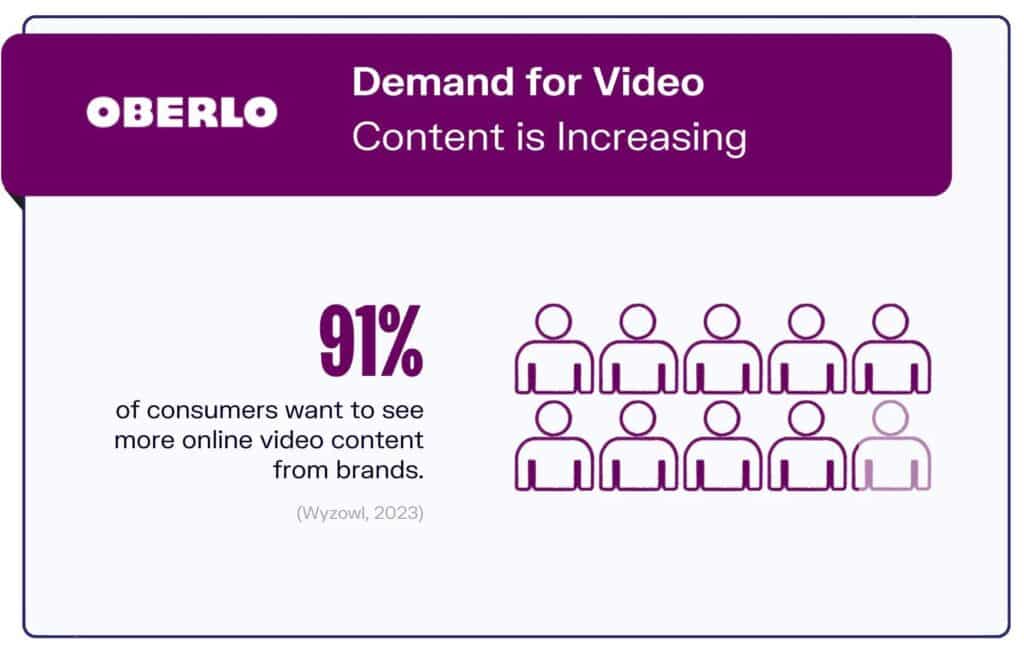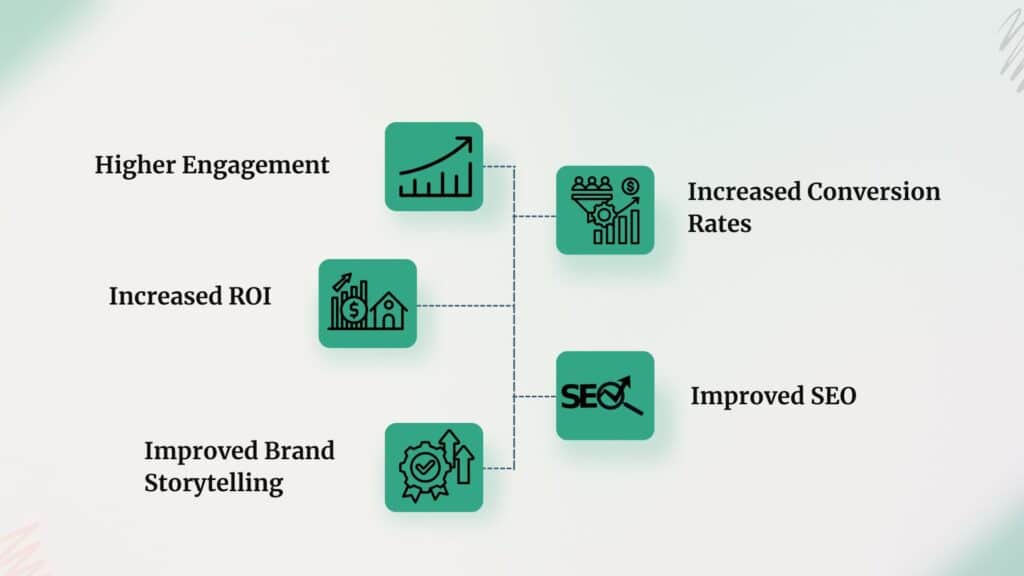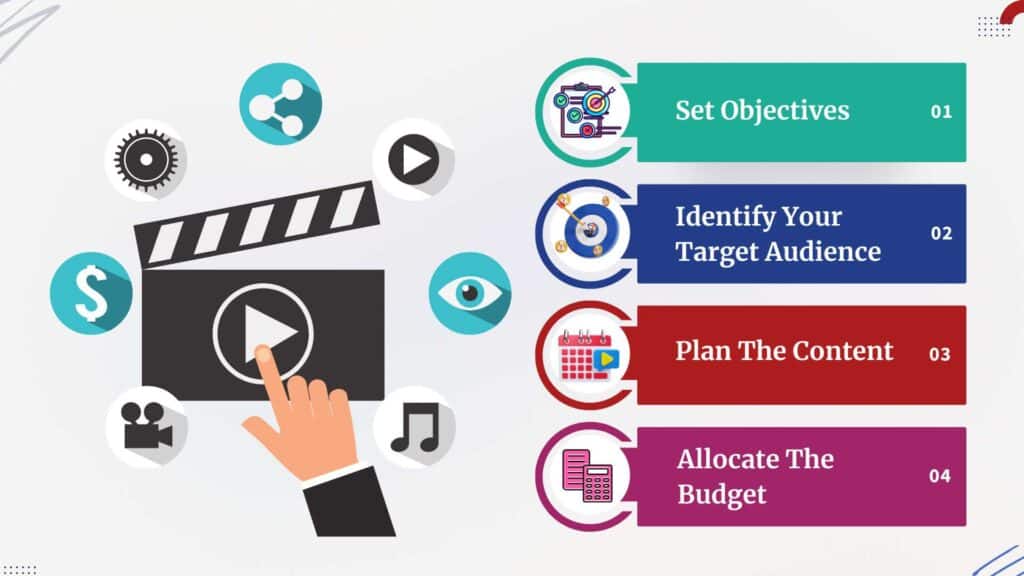Imagine a customer watching your product video, laughing, and then;
Clicking “Buy Now.”
Well! That’s the power of video marketing in 2025!
Welcome to the era where customers trust video testimonials more than customer reviews!
Ah, video marketing!
The one strategy that can make your e-commerce sales skyrocket faster than your cart abandonment rate (ouch, we’ve all been there).
However, here’s the tea: 2025 isn’t just creating videos. It’s about creating experiences that sell. And if you are still stuck with boring product demos, then it’s time to hit the refresh button!
So, grab your virtual button, and let’s explore the ultimate guide to E-commerce video marketing in 2025 – where creativity meets video marketing effectiveness!
Relatable Read: Top 10 Product Video Production Companies For Marketing In 2025
The Evolution Of E-commerce Video Marketing
Video marketing for e-commerce has changed dramatically, going from being a supplemental strategy to becoming a key component of digital strategy.

Historical Overview of Video Marketing
Print, radio, and television ads were the main platforms of marketing. These media offered little interaction and were mostly one-way. Similar to traditional catalogs, early e-commerce used text-based descriptions and static graphics.
A major change was brought about by the development of the Internet and personal computers. This made targeted digital advertising possible.
Moreover, the widespread use of Internet video was made possible by advancements in video compression technology and broadband internet.
Current Situation
The data speaks for itself:
86% of marketing professionals use video as a marketing tool.
E-commerce brands use video for product demonstrations, customer testimonials, and brand storytelling.
Today, people use many platforms to share videos. These include websites, social media (Facebook, Instagram, and TikTok), and streaming services.
Live and interactive videos are becoming more popular because they give viewers a personal experience and allow real-time participation.
Future Outlook
Video ad spending in the United States is expected to reach an astounding $130.97 billion by 2025. The future of e-commerce video marketing appears to be extremely bright.
This increase is a result of the video’s growing ability to:
- Increase conversions
- Foster brand loyalty
Some technological advancements like Artificial intelligence (AI) and augmented reality (AR) are poised to revolutionize video marketing. This enables personalized and immersive experiences.
Moreover, shoppable video content will become more prevalent. As a result, it will allow consumers to make purchases directly from within video players.
Understanding E-commerce Video Marketing
Essentially, video marketing is the deliberate use of videos to advertise and promote a good or service.
In the context of e-commerce, this means using video content to:
- Promote products
- Create brand stories
- Increase sales
This involves telling engaging stories that connect with the audience, not just showcasing products.
- It connects with customers by utilizing the power of visual storytelling.
- It offers a more engaging experience than text or still photos.
- It creates brand personality and cultivates trust.
Relatable Read: 7 Examples Of Exceptional Promotional Videos For Business Success
5 Major Benefits Of Video Marketing

There are many advantages of video marketing. Let’s explore some of them:
- Higher Engagement: Compared to other content types, videos naturally draw and maintain viewers’ attention longer, which raises engagement metrics.
- Increased Conversion Rates: Customer endorsements and product demos have a big impact on decisions to buy, which increases conversion rates.
- Increased ROI: By raising revenue and brand recognition, successful video marketing programs can produce a sizable return on investment.
- Improved SEO: By raising your e-commerce site’s search engine ranks, video content can increase organic visitors.
- Improved Brand Storytelling: Videos let you tell your brand’s distinct story and evoke strong feelings in viewers.
Types Of Videos
Various video formats cater to different e-commerce marketing objectives like:
| Video Type | What They Do |
| Product Demos | Show the capabilities and features of a product in use. |
| Customer Testimonials | Use real customer experiences to establish credibility and trust. |
| Explainer Videos | Make complicated product details or procedures easier to understand. |
| Live Streaming | Show off new products, hold Q&A sessions, and interact with viewers in real-time. |
Relatable Read: Video Ads Vs. Image Ads: Which Performs Better For Your Marketing
Ideal Platforms For Video Types
| Video Type | Platforms |
| Product Demos | Product pages, YouTube, social media platforms |
| Customer Testimonials | Website, social media, YouTube |
| Explainer Videos | Website, social media platforms, YouTube |
| Live Streaming | Social media platforms (Facebook, Instagram, TikTok) |
Relatable Read: 25 Best Marketing YouTube Channels To Follow In 2025
Crafting an Effective E-commerce Video Marketing Strategy

Video marketing is a strong tool to engage consumers and increase conversions in the ever-changing world of e-commerce. A well-thought-out plan is necessary to realize its full potential. Below is a summary of the essential steps:
1. Setting Objectives: Defining Your Vision
Set specific and quantifiable objectives before you start making videos. This gives guidance and makes performance monitoring possible.
Brand Awareness | → Reach a larger audience and try to improve brand recognition. → Metrics include brand mentions, social media shares, and view counts. |
Lead Generation | → For the next marketing campaigns, concentrate on gathering client information. → Metrics include website traffic, email sign-ups, and form submissions. |
Sales Conversion | → Use persuasive calls to action and product demonstrations to increase direct sales. → Metrics include click-through rates, conversion rates, and sales numbers. |
2. Identifying Your Target Audience: Understanding Your Customer
Understanding your audience is essential to producing content that resonates.
Demographics
Age, gender, location, income, and education.
Psychographics
Interests, values, lifestyle, and online behavior.
Customer Journey
To customize the content, map out the steps in your customer’s purchasing process.
Preference and Behavior
- Which platforms are they using?
- What kinds of videos do they watch and interact with?
Relatable Read: Video Productions For Small Businesses: Creative Solutions That Drive Results
3. Content Planning: Creating a Roadmap
A content calendar ensures consistent and relevant video production.
Content Calendar
- Describe the subjects, dates, and distribution methods for the videos.
- Sync up with advertising campaigns, seasonal occasions, and new product launches.
Audience Interest
- Showcase user-generated content, offer product lessons, and address customer pain areas.
Seasonal Trends
- Use themed video material to take advantage of holidays and other special occasions.
- Keep up with what’s popular in your market.
4. Budgeting: Allocating Resources Wisely
A successful return on investment and sustainability of your video marketing initiatives are guaranteed by efficient budgeting.
Production Costs
Equipment, filming, editing, and professional talent.
Distribution Costs
Platform advertising, social media promotion, and influencer marketing.
Promotion Costs
Paid advertisements, social media boosting, and email marketing.
Analysis and Optimization
- Set aside money to track outcomes and improve your approach.
- Think about A/B testing various promotional tactics and video versions.
Producing High-Quality E-Commerce Videos
Pre-production, production, and post-production are the three crucial stages in the process of making successful e-commerce videos.
1. Pre-Production Planning: Laying the Foundation
This important step lays the groundwork for a successful and smooth video session.
Scripting
- Write a short and straightforward script that emphasizes the salient characteristics and advantages of the product.
- Consider your intended audience and adjust the tone and wording appropriately.
- Concentrate on delivering a compelling story to engage viewers emotionally.
Storyboarding
- Make a storyboard that describes every scene to visualize the video’s flow.
- This guarantees a seamless story and a productive shooting procedure.
- Consider the composition of the shot and the intended display of the product.
Equipment Selection
- Pick the appropriate camera, lighting, and sound equipment depending on your production needs and budget.
- For fluid camera motions, think about using tripods and stabilizers.
- To prevent low sound quality, make sure you have the right audio recording equipment.
Relatable Read: Film Clapperboard: Your Essential Tool For Professional Video Production
2. Production Tips: Capturing The Magic
Attention to detail plays a big role during production. Let’s explore some production tips to create magic.
Lighting
- To produce a well-lit and eye-catching video, use either artificial or natural lighting.
- Avoid sharp shadows and make sure the lighting is constant during the photo session.
- To achieve the appropriate ambiance, consider various lighting configurations.
Sound
- To improve the experience of the audience, record audio that is clean and sharp.
- For the best sound quality, use a microphone and reduce background noise.
- Before and during recording, check the sound quality.
Framing Techniques
- To keep the film interesting, experiment with different camera angles and viewpoints.
- Emphasize the salient characteristics of the product and highlight its capabilities.
- Make sure you’re focused on the product.
3. Post-Production: Polishing And Refining
Post-production brings the video to its final form. Let’s explore the last steps of post-production:
Editing Essentials
- Use video editing tools to organize, cut, and trim clips.
- Add music, effects, and transitions to improve the video’s visual and aural appeal.
- Make sure the rhythm and flow go hand in hand.
Adding Branding Elements
- Include your logo, colors, and typefaces to establish a consistent brand identity.
- Highlight important information using on-screen text and images.
- Keep your brand consistent.
Adding Calls-To-Action (CTAs)
- Add attention-grabbing and persuasive calls to action (CTAs) like “Shop Now” OR “Learn More.”
- CTAs should be positioned thoughtfully at the end and throughout the video.
- Use visual clues to help direct the viewer’s attention to the CTA.
Optimizing Videos For E-Commerce Platforms
Making videos isn’t enough, it’s also important to optimize them for e-commerce sites.
1. Smooth Website Integration For Enhanced Product Pages
Embedding For Engagement
- Put videos on product pages in strategic locations to highlight features, show off how to use them, and create a more engaging experience.
- Make sure movies load fast and are responsive to prevent annoying potential buyers.
- Use obvious call-to-actions in the video or next to it to encourage viewers to make a purchase.
Boosting Conversion Rates
- Using videos that portray a product can greatly lessen consumer hesitancy. As a result, it increases conversion rates.
- Videos that feature customer testimonials build social proof and trust. It promotes purchases.
2. Social Media For Maximum Reach
Platform-Specific Strategies
Instagram and TikTok: Focus on short-form, eye-catching material that grabs readers’ attention right away. Make use of challenges and popular noises to boost virality.
YouTube: Use longer-form video content like product reviews, tutorials, and behind-the-scenes footage.
Relatable Read: Wistia Vs. Vimeo: Pros, Cons, And Which Platform Wins For Businesses
Short-Form Video Dominance
- Make brief, powerful videos that, in a matter of seconds, show the salient features and advantages of your products.
- Make use of social media’s integrated purchasing capabilities to link videos to product pages immediately.
3. Implementing SEO Best Practices
Optimizing Video Metadata
- Create intriguing titles that appropriately convey the video’s content and are packed with keywords.
- Create thorough descriptions with links to product pages and relevant keywords.
- Use pertinent tags to classify videos and increase their search ranking presence.
Enhancing Search Rankings
- Use transcripts and closed captions to increase accessibility and give search engines useful text content.
- Ask viewers to like, comment, and share videos to increase engagement signals.
- Make sure that the platforms on which videos are hosted facilitate the search engine indexing.
Relatable Read: Video SEO In 2025: 10 Proven Tips To Improve Your Websites Rankings
Utilizing Trends in 2025
The modern customer expects a smooth and interesting experience. Here’s how to live up to their standards:
Shoppable Videos
The purchasing process will be significantly less complicated with direct purchase links included in videos. Imagine adding a dress to your cart right away after clicking on it in a video featuring an influencer.
This trend will increase conversion rates and encourage impulsive purchases.
Live Streaming
Live commerce offers instant feedback and real-time customer engagement. Moreover, brands can hold exclusive sales events, product demos, and live Q&A sessions. This increases sales by building a sense of urgency and community.
User-Generated Content (UGC)
Authenticity is important and videos made by customers will increase credibility and confidence. Encourage customers to post video reviews and testimonials about their experiences using your items.
Measuring the Success of Video Marketing Campaigns
Key Metrics
| View Counts | Track the reach of your videos. |
| Engagement Rates | Measure likes, comments, shares, and watch time to gauge audience interest. |
| Conversion Rates | Analyze how many viewers take desired actions like making a purchase or signing up for a newsletter |
Analytical Tools
Use tools to keep an eye on video performance like:
- Social media analytics dashboards
- YouTube Analytics
- Google Analytics
Iterative Improvement
Analyze data regularly to find areas that need development. Moreover, to maximize performance, A/B tests various video formats, content, and calls to action.
It will be crucial to use the data to improve future video efforts.
Final Words
E-commerce video marketing in 2025 is all about authenticity, engagement, and strategic distribution.
So. are you ready to improve your E-commerce video strategy? Partner with LocalEyes today and transform your video marketing into a powerful sales engine!
FAQs
What prospects does marketing have in 2025?
Data-driven, highly customized marketing that emphasizes immersive experiences will be used.
In 2025, how much need will there be for digital marketing?
With companies depending on digital marketing to connect with their target audiences and spur expansion, there will be a huge need.
How will marketing change over the next five years?
Virtual reality (VR) and augmented reality (AR) will play a bigger part in more interactive marketing. Data privacy and personalized experiences will be major issues. The dominance of short-form videos will only increase.

Founder at LocalEyes Video Production | Inc. 5000 CEO | Emmy Award Winning Producer



